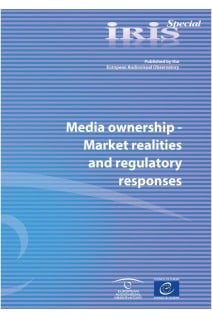



One of the pillars of freedom of expression in the audiovisual sector is media pluralism. This concept covers, on the one hand, the availability of a variety of choice in the programming of the different media players. On the other hand, it concerns the effective presence of a multitude of operators so as to avoid an excessive concentration of the market.
Media pluralism, as such, has been widely explored by legislation and case-law both at the national and European levels. A related issue is the need for ensuring transparency of the financing of the various media providers, and an adequate knowledge of their ownership structure and control or influence.
For these purposes most countries have put in place tools and mechanisms to allow for the collection of the necessary information, which also allows the European Audiovisual Observatory (EAO) to compile a certain proportion of this data. Other sources of information are made available by regulatory bodies throughout Europe, and administrative case-law, which is also related to competition issues, completes the picture.
This IRIS Special provides an overview of the current market realities and a selection of regulatory responses that have been put in place across Europe since the Observatory’s report on “Converged markets – converged power? Regulation and case law” of 2012. It has been prepared by the Institute of European Media Law (EMR) in Saarbrücken and collects contributions from various authors.
IRIS Special focuses on a selection of European countries, which have been chosen with the intention of providing a set of different approaches:
Germany, United Kingdom, Italy, France, Spain, and Poland.
Content list
1. Introduction: media ownership in European markets
1.1. Introduction
1.2. Examining media ownership, data, and transparency
1.3. National media systems and concentration
1.4. Pan-European broadcast media groups
1.5. Pan-European distribution companies
1.6. Pan-European groups and content
1.7. Concluding remarks and potential further research
2. Guaranteeing media diversity at European level
2.1. Introduction
2.2. Legal framework
2.3. Measures to prevent media concentration at European Union level
2.4. Measures to prevent media concentration at Council of Europe level
2.5. The impact of media-related relevant markets
2.6. Conclusion
3. Instruments to measure media and publicise concentration – the example of the Media Pluralism Monitor
3.1. Introduction
3.2. Why measure concentration of media ownership? The rationales underpinning the ‘Market Plurality Domain’
3.3. How to measure the concentration of media ownership: The methodology underpinning the ‘Market Plurality Domain’
3.4. Results of the 2015 Implementation of the Media Pluralism Monitor
3.5. Taking stock of lessons learnt: The 2016 Implementation of the Media Pluralism Monitor
4. Media concentration in Germany
4.1. Constitutional basis for the protection of diversity of opinion
4.2. Media markets
4.3. Legislative provisions to prevent media concentration
4.4. KEK decision in the Springer/ProSiebenSat.1 case
4.5. Proposed reforms
4.6. Other media-relevant factors
4.7. Shareholding restrictions in the media sector
5. Media concentration in the United Kingdom
5.1. Constitutional Background
5.2. Convergent Audiovisual Media Markets
5.3. Prevention of media concentration by law
5.4. Key Decisions
5.5. Current Discussion
5.6. Specific Restrictions on Ownership
5.7. Other Considerations
6. Media concentration in Italy
6.1. Constitutional background
6.2. Convergent audiovisual/media markets
6.3. Prevention of media concentration by law
6.4. The importance of media related factors and markets
6.5. Specific Ownership Restrictions/Barriers to Ownership
6.6. Current discussion
7. Media concentration in France
7.1. Summary
7.2. Constitutional context
7.3. Delimitation of agreements and effects of convergence
7.4. Supervision and prevention of concentration in the audiovisual sector
8. Spain
8.1. Constitutional background
8.2. Convergent audiovisual / media markets
8.3. Prevention of media concentration by law
8.4. Key decision(s)
8.5. Current discussion
8.6. Specific Ownership Restrictions / barriers to Ownership
8.7. References
9. Media concentration in Poland
9.1. Constitutional background
9.2. Convergent audiovisual/media markets
9.3. Prevention of media concentration by law
9.4. Current discussion
10. Conclusions
10.1. The importance of guaranteeing media pluralism
10.2. The importance of European provisions for the protection of media diversity
10.3. Summary of the main findings in the states examined
10.4. Challenges created by convergence









One of the pillars of freedom of expression in the audiovisual sector is media pluralism. This concept covers, on the one hand, the availability of a variety of choice in the programming of the different media players. On the other hand, it concerns the effective presence of a multitude of operators so as to avoid an excessive concentration of the market.
Media pluralism, as such, has been widely explored by legislation and case-law both at the national and European levels. A related issue is the need for ensuring transparency of the financing of the various media providers, and an adequate knowledge of their ownership structure and control or influence.
For these purposes most countries have put in place tools and mechanisms to allow for the collection of the necessary information, which also allows the European Audiovisual Observatory (EAO) to compile a certain proportion of this data. Other sources of information are made available by regulatory bodies throughout Europe, and administrative case-law, which is also related to competition issues, completes the picture.
This IRIS Special provides an overview of the current market realities and a selection of regulatory responses that have been put in place across Europe since the Observatory’s report on “Converged markets – converged power? Regulation and case law” of 2012. It has been prepared by the Institute of European Media Law (EMR) in Saarbrücken and collects contributions from various authors.
IRIS Special focuses on a selection of European countries, which have been chosen with the intention of providing a set of different approaches:
Germany, United Kingdom, Italy, France, Spain, and Poland.
Attention, en vertu de nos conditions générales de vente, l'achat des PDF/epub est réservé aux particuliers.
